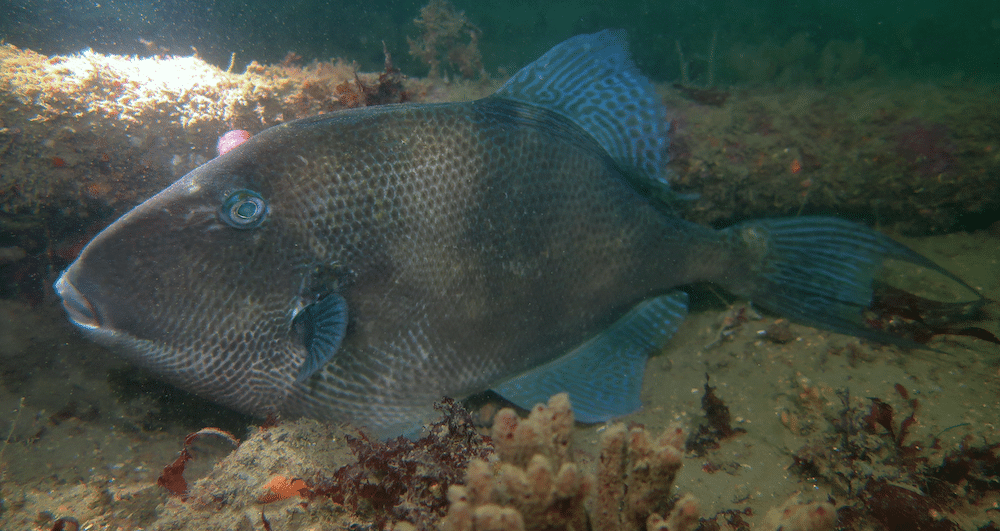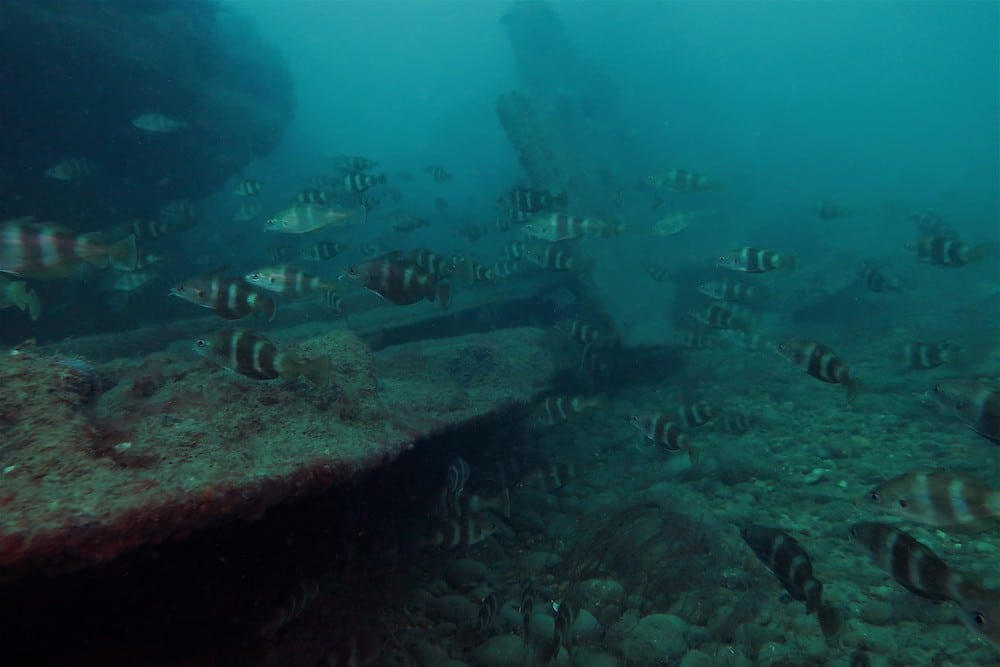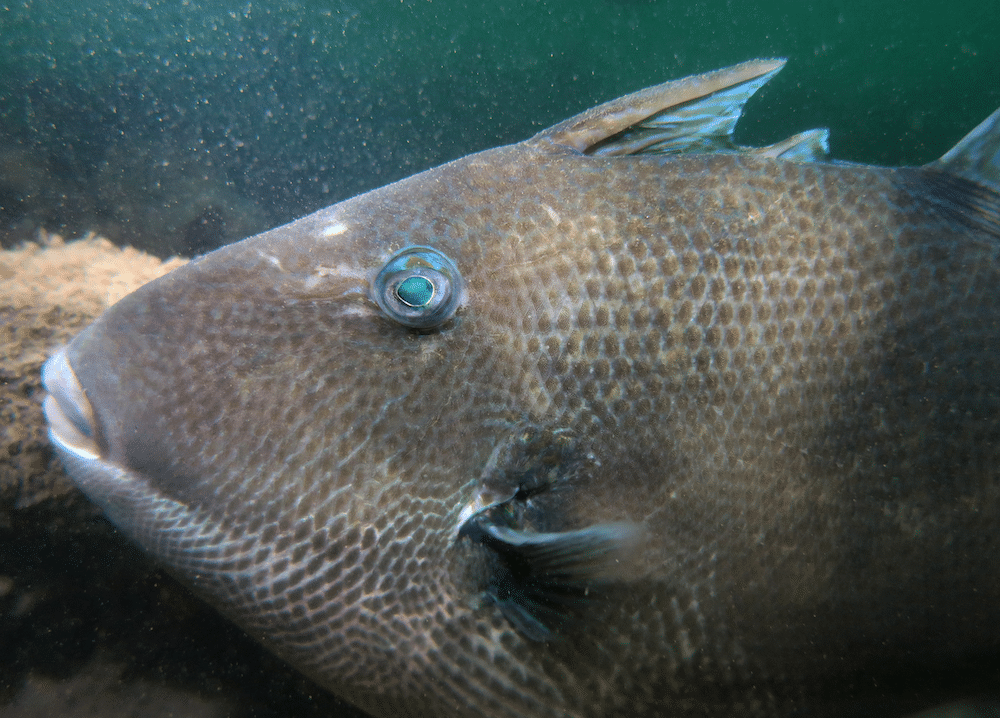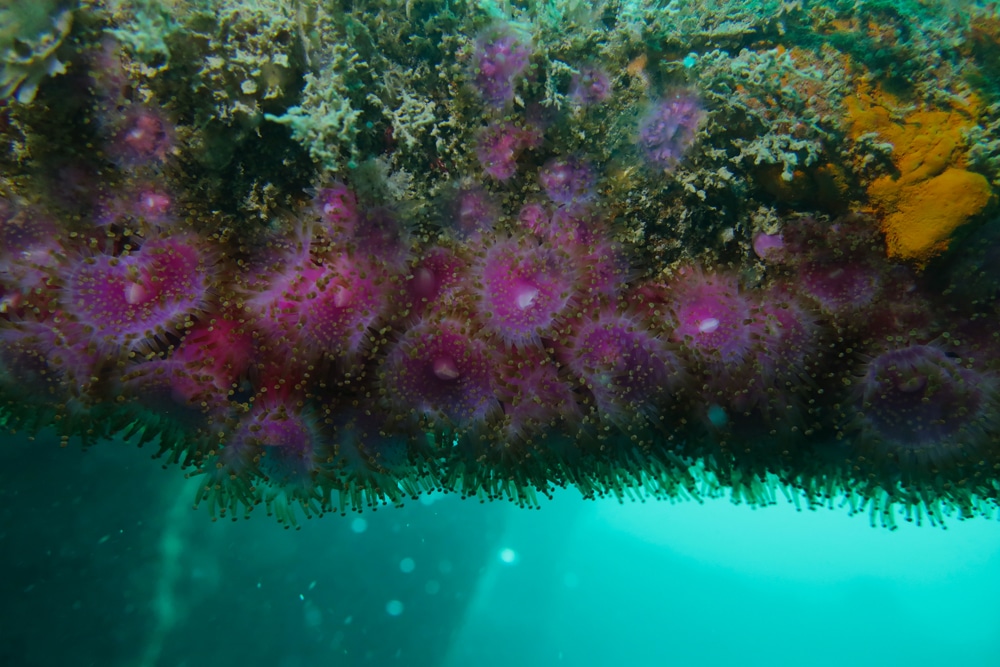News
Diving with British Marine Life: The Grey Triggerfish

Part 2 of a new series by blogger Georgie Bull…
Before starting University last September, I dove Chesil Cove in the hope that I could get a glimpse of a triggerfish on the Royal Adelaide wreck. Grey triggerfish (Balistes capriscus) are seasonal visitors to our waters and are known to congregate on the wreck at a similar time each year. They are often fished off or battered by storms fairly rapidly, so sightings are temporally confined too.
For anyone unfamiliar with Chesil, large pebble ridges create a wonderful pre and post dive work out for any diver keen enough to get in. Jon Bunker (Instagram: @jon_bunker) my Dorset dive buddy did a fantastic job of locating the wreck, and we had a very pleasant dive overall. Jon has invited me along on lots of his diving antics, and he’s the main reason I have so many photos to share.
On the dive we saw the likes of jewel anemones, congers, and a wonderful variety of wrasse. Without a trigger in sight, a couple of tompot blennies fighting one another became the main highlight. After the dive we spoke to a recreational angler on the beach, who mentioned he’d caught (and returned) a triggerfish while we were in the water. We were so close to a sighting!
Once I’d recovered from the pebble ridges and put my kit away, I accepted that I’d have to wait until next year.
Fast forward to a few weeks time, and the University of Plymouth’s Scuba Society were running their first shore club dive at Firestone Bay. I joined in, hoping to see a few different tunicates or echinoderms that I may not see so often in Lyme Bay. Instead, I was greeted with a large and relatively healthy triggerfish sat on the substrate. It turns out, I didn’t need to scale pebble ridges or use Jon’s impressive navigation skills to have an encounter with this species!

Profile
Triggerfish have defensive spines on their dorsal which are used to avoid predation, but also wedge themselves into crevices outside of harms way. Like their namesake suggests, the erection of their largest spine is triggered by the depression of a smaller spine closer to their head. Triggerfish are also known for aggressive behaviour, as they are particularly territorial over their nests.

Grey triggerfish are a Southern European species, and are valued by anglers both commercially and recreationally. This value has resulted in them being categorised as ‘vulnerable’ by IUCN. They are also the only triggerfish encountered in UK waters, with the other 39 species of triggerfish found typically in warmer waters.
Literature
In recent years, it’s been reported that grey triggerfish are becoming increasingly common in the UK. We have plenty of evidence to suggest that our oceans are warming, and we know from previous instances that migratory pelagic fish like the grey triggerfish are capable of shifting their distribution in response to environmental change.
In 1930, a grey triggerfish was recorded in St Malo, France; by the 1990s, they were being described as common in Jersey. In southern parts of the UK grey triggerfish sightings were unheard of too, up until the early 2000s. They are now regarded as common in some areas (like Chesil) at certain times of the year. It would be interesting to see this shift quantified more and understand if the increased catch rates may also be influenced by changing fishing methods and intensity.

References:
- https://www.fisheries.noaa.gov/species/gray-triggerfish
- https://www.iucnredlist.org/species/193736/97662794#threats
- https://www.bbc.co.uk/news/world-europe-jersey-46591920
- https://www.gov.je/SiteCollectionDocuments/Government%20and%20administration/R%20Non-native%20Marine%20Species%20in%20the%20Channel%20Islands%2020171222%20DM.pdf
Hear more from Georgie here: https://georgiebullphotography.home.blog/
Gear News
Introducing the TR-80, IR-50 and CS-30 Regulators from DYNAMICNORD

Whether you are a beginner or a professional diver – with the three new main regulators from DYNAMICNORD, everyone will find their favourite regulator. They all look super stylish.
Excellent performance with the TR-80
Quality and performance are the be-all and end-all for regulators. It is not for nothing that the TR stands for Tec Reg. The innovative design of the TR-80 guarantees absolute reliability – even in ice-cold waters.

Perfect breathing effort at 0.8 J/l / certified for diving in waters below 10 degrees / structural design made of solid brass for best cold protection / membrane-compensated design with dry seal of the first stage / reduced exhalation effort thanks to optimized exhalation membrane and bubble deflector / adjustable Venturi (dive/predive) and adjustment knob for individual inhalation comfort / innovative design of the front cover prevents free-flow in strong currents or when diving with scooters / design made of sandblasted brass, matt chrome finish / 2 HP and 4 LP outlets / mouthpiece made of high-quality, anti-allergic silicone for maximum comfort.


Amazing underwater adventures with the IR-50
The IR-50 is the top regulator for advanced and experienced divers. Natural breathing is the essence of this regulator.

Ideal breathing effort at 0.8 J/l /certified for diving in waters below 10 degrees / compensated membrane / adjustable venturi (dive/predive) and adjustment knob for individual inhalation comfort/ outlet valve and deflector for minimum exhalation effort and reduction of bubbles on the face / design made of sandblasted brass, matt chrome finish / 2 HP and 4 NP outlets / mouthpiece made of high-quality, anti-allergic silicone for maximum comfort.


The Workhorse – our CS-30
For diving centres and diving beginners – the workhorse stands for strong construction, reliability and robustness. Perfect for your training.

Optimal breathing effort at 0.8 J/l /recommended for diving in waters above 10 degrees / non-compensated piston / adjustable venturi (dive/predive) / outlet valve and deflector for minimum exhalation effort and reduction of bubbles on the face / design made of sandblasted brass, matt chrome finish / 1 HP and 3 NP outlets / mouthpiece made of high-quality, anti-allergic silicone for maximum comfort.


Octopus OP-30
The OP-30 is the ideal addition to all DYNAMICNORD regulators. It is identical in construction to the CS-30.

The TR-80, IR-50, CS-30 (DIN & INT) regulators and the Octopus OP-30 are available from DYNAMICNORD dealers and in the online store.
DYNAMICNORD – Your Outdoor Companion.
Marine Life & Conservation
Paul Watson Released as Denmark Blocks Japan’s Extradition Bid

Renowned anti-whaling activist Paul Watson has been released from custody in Greenland after spending five months in detention. Denmark’s Justice Ministry rejected Japan’s request for his extradition, citing insufficient guarantees that his time already served in custody would be credited against any potential sentence.
The 74-year-old Canadian-American was arrested on July 21 in Nuuk, Greenland’s capital, when his ship docked to refuel. His arrest was based on a 2012 Japanese warrant related to a 2010 encounter in Antarctic waters. Japan alleged Watson obstructed operations and caused damage to a whaling research ship during efforts to disrupt illegal whaling. Watson has consistently denied these claims, maintaining his commitment to marine conservation.
Denmark, which oversees extradition matters for Greenland, concluded that while the legal conditions for extradition were met, the lack of assurances from Japan regarding time-served credit made extradition untenable.
In a video shared by his foundation, Watson expressed gratitude and relief, saying, “After five months, it’s good to be out… and good to know they’re not sending me to Japan.” He added that the most difficult part of his time in custody was being separated from his two young sons.
Watson is a pioneering figure in marine conservation, known for founding the Captain Paul Watson Foundation in 2022 after decades of activism with the Sea Shepherd Conservation Society. His bold efforts to defend marine life have earned him widespread support, including from celebrities and conservationists. His work has also been featured in the acclaimed reality TV series Whale Wars.
Watson’s lawyer, Jonas Christoffersen, praised the decision, stating, “We are happy and relieved that Paul Watson is now free.” He added that Watson is eager to reunite with his family and continue his vital work.
The arrest occurred while Watson’s vessel, the M/Y John Paul DeJoria, was en route to the North Pacific with a team of 26 volunteers to intercept a Japanese whaling ship. His foundation described the arrest as politically motivated and emphasized that Watson’s actions were focused on ending illegal whaling practices.
Japan resumed commercial whaling in 2019 after leaving the International Whaling Commission, asserting that whale meat is a cultural tradition. Conservationists, however, continue to challenge these practices, highlighting their impact on marine ecosystems.
Despite the challenges, Watson remains steadfast in his mission to protect marine life and bring attention to whaling practices. His dedication to ocean conservation has made him a globally respected advocate for the environment.
-

 News2 months ago
News2 months agoIconic SS United States to become the World’s Largest Artificial Reef
-

 News3 months ago
News3 months agoBook Review – 52 Assignments: Underwater Photography
-

 Gear News3 months ago
Gear News3 months agoDYNAMICNORD – New German diving brand enters the British market
-

 News3 months ago
News3 months agoExploring Cenote El Pit: A Diver’s Dream
-

 Gear News3 months ago
Gear News3 months agoTry BARE drysuits (and maybe even win one!) this Friday with Sea & Sea at North West Dive Fest
-

 Marine Life & Conservation3 months ago
Marine Life & Conservation3 months agoBook Review: Coral Triangle Cameos
-

 Blogs2 months ago
Blogs2 months agoDive the Egyptian Red Sea this Autumn with Regaldive
-

 News3 months ago
News3 months ago2024 Ocean Art Underwater Photo Competition Announced
















